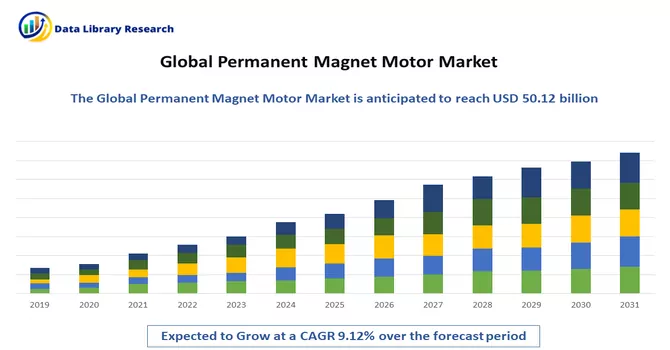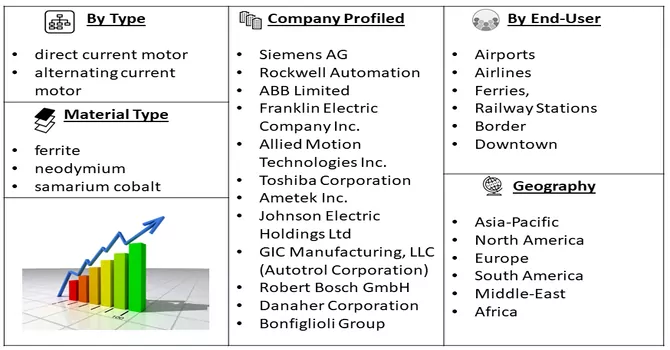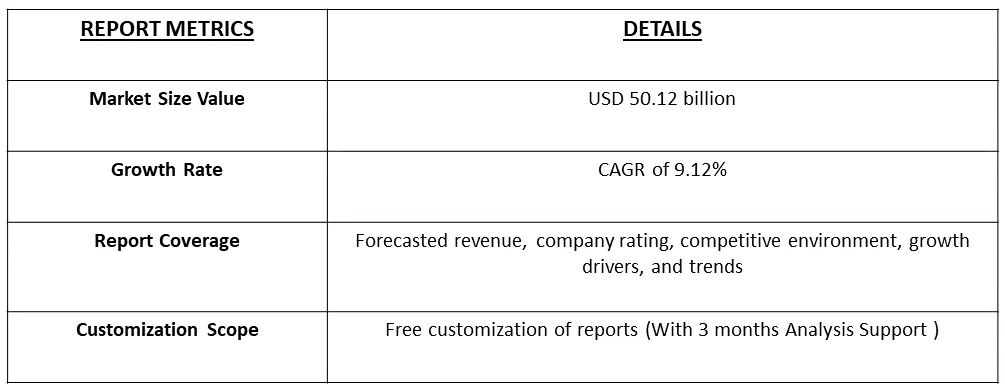The Permanent Magnet Motor Market is anticipated to expand from an estimated USD 50.12 billion in 2023 exhibiting a Compound Annual Growth Rate (CAGR) of 9.12% during the forecast period (2023-2030).

Get Complete Analysis Of The Report - Download Free Sample PDF
A permanent magnet motor is an electric motor that relies on permanent magnets, such as those made from neodymium or ferrite, to generate the necessary magnetic field for its operation. Unlike traditional electric motors, which depend on electromagnetic fields produced by wire coils, permanent magnet motors incorporate fixed magnets, eliminating the need for an external power source to generate the field. These motors are recognized for their efficiency, compact design, and enhanced performance across various applications, including electric vehicles, industrial machinery, and consumer electronics.
The market's growth is propelled by the increasing demand for electric vehicles and the rising adoption of permanent magnet motors in the industrial sector. Ongoing advancements in motor efficiency further contribute to the widespread adoption of permanent magnetic motors across different end-user verticals. Permanent magnet motors (PMM) are experiencing a notable surge in demand owing to their high efficiency and versatility. They find application in a broad spectrum of uses, ranging from stepping motors in wristwatches and industrial drives for machine tools to large PM synchronous motors used in ship propulsion.
The surge in demand for electric vehicles (EVs), driven by the growing emphasis on sustainable transportation, is propelling the adoption of permanent magnet motors. These motors play a critical role in electric propulsion systems, providing a combination of high efficiency and performance, thus fueling market growth. Additionally, there is an increasing demand for permanent magnet motors across various industrial applications. Sectors such as manufacturing, robotics, and machinery are progressively integrating these motors into their systems, attracted by their compact design, energy efficiency, and improved operational performance. Ongoing advancements in magnet materials, especially the development of high-performance options like neodymium, are instrumental in shaping market trends. The continuous improvement in magnet materials contributes to elevated motor efficiency and performance, fostering innovation within the permanent magnet motor market. Together, these trends are driving the dynamic growth and evolution of the Permanent Magnet Motor Market.
Market Segmentation: The Global DC Permanent Magnet Motor Market Report is segmented by motor type (direct current motor, alternating current motor), magnetic material type (ferrite, neodymium, samarium cobalt), end-user vertical (general industrial, automotive, energy, water, and wastewater management, mining, oil, and gas, aerospace, and defense), and Geography (North America, Europe, Asia-Pacific, Middle East and Africa, and South America). The value is provided in (USD million) for the above segments.

For Detailed Market Segmentation - Download Free Sample PDF
Market Drivers :
Increased Motor Efficiency due to Permanent Magnets
The utilization of permanent magnets in electric motors has led to a substantial increase in motor efficiency across various applications. Unlike traditional motors that rely on electromagnets created by coils of wire, permanent magnet motors incorporate fixed magnets, typically made of materials such as neodymium or ferrite. These magnets generate a constant magnetic field within the motor, eliminating the need for a separate power source to create the field. One of the key advantages of permanent magnet motors is their enhanced efficiency in converting electrical energy into mechanical power. The presence of permanent magnets allows for a more direct and efficient transfer of magnetic energy, resulting in reduced energy losses during operation. This improved efficiency translates into several benefits, including lower energy consumption, reduced heat generation, and increased overall performance.
Rising Demand for Electric Vehicles
The growing demand for electric vehicles (EVs) is a key driving force behind the increased adoption of Permanent Magnet Motors (PMMs). As the automotive industry undergoes a significant shift toward electric mobility, PMMs play a crucial role in powering electric vehicles efficiently. With a growing emphasis on environmental sustainability, electric vehicles are increasingly seen as a cleaner and greener alternative to traditional gasoline-powered vehicles. The eco-friendly image of EVs further boosts their popularity and, consequently, the demand for PMMs. As the automotive industry continues to transition toward electrification, the demand for Permanent Magnet Motors is expected to remain on an upward trajectory, driven by the expanding market for electric vehicles.
Market Restraints :
The diminishing availability of rare-earth metals poses a significant challenge to the growth of the magnet motor market, particularly for motors that heavily rely on these scarce materials. Rare-earth metals, including neodymium, dysprosium, and praseodymium, are essential components in the production of high-performance permanent magnets used in various types of magnet motors, such as neodymium magnets in Permanent Magnet Motors (PMMs). Permanent magnets, especially neodymium magnets, are integral to the functionality of many modern magnet motors due to their exceptional magnetic properties. These magnets are crucial in applications ranging from electric vehicle propulsion to industrial machinery. Thus, the diminishing availability of rare-earth metals presents a significant challenge to the magnet motor market. Industry stakeholders are actively engaged in research and development initiatives to address these challenges and find sustainable solutions to maintain the growth and reliability of magnet motor technologies.
The COVID-19 pandemic has had a notable impact on the Permanent Magnet Market, influencing various aspects of production, supply chains, demand, and overall market dynamics. The pandemic led to disruptions in global supply chains, affecting the production and distribution of permanent magnets. Lockdowns, restrictions on movement, and factory closures in many regions disrupted the supply of raw materials and components necessary for magnet manufacturing. The slowdown in industrial activity, including manufacturing and automotive production, resulted in decreased demand for permanent magnets. Industries that heavily rely on permanent magnets, such as automotive and electronics, experienced a decline in production and sales. Thus, the COVID-19 pandemic had multifaceted effects on the permanent magnet market, impacting supply chains, demand dynamics, and the pace of technological developments. The market has demonstrated resilience, and the long-term trajectory will be shaped by ongoing recovery efforts, global economic trends, and the continued emphasis on sustainable technologies.
Segmental Analysis :
AC Magnet Motor is Expected to Witness Significant Growth Over the Forecast Period
The COVID-19 pandemic has had a notable impact on the Permanent Magnet Market, influencing various aspects of production, supply chains, demand, and overall market dynamics. The pandemic led to disruptions in global supply chains, affecting the production and distribution of permanent magnets. Lockdowns, restrictions on movement, and factory closures in many regions disrupted the supply of raw materials and components necessary for magnet manufacturing. AC motors can be controlled using various methods, including variable frequency drives (VFDs), which allow for speed control and energy savings. Soft starters and motor starters are employed to control the starting and stopping of AC motors, reducing mechanical and electrical stress. Thus, alternating current motors play a fundamental role in powering a diverse range of devices and machinery, contributing to their widespread adoption across industries and daily life.
Neodymium Permanent Magnet Segment is Expected to Witness Significant Growth Over the Forecast Period
A neodymium permanent magnet is a type of rare-earth magnet that belongs to the family of permanent magnets. These magnets are made from an alloy of neodymium, iron, and boron (NdFeB), which is why they are often referred to as NdFeB magnets. Neodymium magnets are known for their exceptional strength, making them the most powerful commercially available magnets. Neodymium magnets are composed of neodymium, iron, and boron. The combination of these elements creates a crystalline structure, resulting in a powerful magnetic field. Neodymium magnets are the strongest type of permanent magnets available commercially. They have a high magnetic energy product, providing superior magnetic strength compared to other types of magnets. Thus, neodymium permanent magnets have revolutionized various industries and technologies by providing a compact and powerful magnetic solution. Their strength and versatility make them integral components in many modern electronic devices and machinery.
Automotive Segment is Expected to Witness Significant Growth Over the Forecast Period
The automotive industry extensively utilizes permanent magnets, especially neodymium magnets, due to their exceptional strength and efficiency. Permanent magnets play a crucial role in electric motors used in electric and hybrid vehicles. Neodymium magnets, in particular, are commonly employed in the construction of the rotor (the rotating part) of the motor. Their strong magnetic properties contribute to the efficiency and performance of electric vehicles. Permanent magnet motors, specifically brushless DC (BLDC) motors, are widely used in various automotive applications. These motors, featuring neodymium or other rare-earth magnets, are preferred for their compact design, high torque-to-weight ratio, and efficiency. Thus, the automotive segment relies on the unique properties of permanent magnets, especially neodymium magnets, to enhance the efficiency, performance, and sustainability of various vehicle components and systems. The transition toward electric mobility has further emphasized the importance of permanent magnets in the automotive industry.
North America Region is Expected to Witness Significant Growth Over the Forecast Period
The North American region is poised to secure a significant global market share, driven by escalating investments from industry players, organizational initiatives, and governmental programs aimed at fostering energy-efficient and sustainable practices. The robust growth of the wind energy sector in the region is anticipated to propel the permanent magnet market's expansion during the forecast period.
As the emphasis on energy-efficient solutions intensifies, industries throughout the region are increasingly adopting Permanent Magnet Motors (PMM) across various factory operations, contributing to the market's augmentation. Canada, in particular, is actively addressing energy consumption concerns through initiatives like the Canada Industry Program for Energy Conservation (CIPEC). Geomega Resources Inc., a cleantech developer specializing in rare earth mining and recycling, collaborates with USA Rare Earth to recycle production waste containing rare earth elements. This waste originates from the production of sintered neodymium iron boron permanent magnets (sintered neo magnets) by USA Rare Earths in the United States. Such initiatives are anticipated to boost PMM adoption, particularly in sectors like wind energy, which holds significant prominence in the North American region.
Additionally, researchers at the University of Pittsburgh have partnered with Powdermet Inc., an advanced materials research and development company in Ohio, to develop a rare-earth mineral-free electric motor. This collaborative project aims to create an electric machine utilizing permanent magnets crafted from more abundant metals rather than relying on rare-earth metals. These initiatives collectively underscore the region's commitment to sustainable practices and technological advancements in the field of permanent magnet application.

Get Complete Analysis Of The Report - Download Free Sample PDF
The Permanent Magnet Motor Market is characterized by high competition, where market players can gain a competitive edge and expand their market share through innovations and investments in research and development (R&D). The competitive rivalry within the market is anticipated to intensify, driven by factors such as expanding market penetration and the implementation of robust competitive strategies by industry participants. The landscape is dynamic, with companies vying to differentiate themselves through technological advancements and strategic initiatives to strengthen their positions in the market. This heightened competition is expected to foster innovation and contribute to the overall growth and development of the Permanent Magnet Motor Market. Some of the market players working in this segment are :
Recent Development
1) In July 2023, WEG made a strategic investment of USD 9.83 million to enhance its motor manufacturing production capacity in Brazil. The primary objective of this investment is to introduce a new series of permanent magnet electric motors designed specifically for air conditioners.
2) In December 2022, a consortium of engineering firms in the UK initiated a government-supported project with a total funding of GBP 6 million (equivalent to USD 7.23 million). The project is dedicated to developing advanced manufacturing processes for electric motors. The specific focus is on designing and implementing production methods conducive to high-volume manufacturing of permanent magnet motors, with a particular emphasis on their application in electric vehicles.
Q1. What was the Permanent Magnet Motor Market size in 2023?
As per Data Library Research 2the Permanent Magnet Motor Market is anticipated to expand an estimated USD 50.12 billion in 2023.
Q2. At what CAGR is the Permanent Magnet Motor Market projected to grow within the forecast period?
Permanent Magnet Motor Market is exhibiting a Compound Annual Growth Rate (CAGR) of 9.12% during the forecast period.
Q3. What are the factors driving the Permanent Magnet Motor Market?
Key factors that are driving the growth include the Increased Motor Efficiency due to Permanent Magnets and Rising Demand for Electric Vehicles.
Q4. Which Region is expected to hold the highest Market share?
North America region is expected to hold the highest Market share.
Data Library Research are conducted by industry experts who offer insight on industry structure, market segmentations technology assessment and competitive landscape (CL), and penetration, as well as on emerging trends. Their analysis is based on primary interviews (~ 80%) and secondary research (~ 20%) as well as years of professional expertise in their respective industries. Adding to this, by analysing historical trends and current market positions, our analysts predict where the market will be headed for the next five years. Furthermore, the varying trends of segment & categories geographically presented are also studied and the estimated based on the primary & secondary research.
In this particular report from the supply side Data Library Research has conducted primary surveys (interviews) with the key level executives (VP, CEO’s, Marketing Director, Business Development Manager and SOFT) of the companies that active & prominent as well as the midsized organization
FIGURE 1: DLR RESEARH PROCESS

Extensive primary research was conducted to gain a deeper insight of the market and industry performance. The analysis is based on both primary and secondary research as well as years of professional expertise in the respective industries.
In addition to analysing current and historical trends, our analysts predict where the market is headed over the next five years.
It varies by segment for these categories geographically presented in the list of market tables. Speaking about this particular report we have conducted primary surveys (interviews) with the key level executives (VP, CEO’s, Marketing Director, Business Development Manager and many more) of the major players active in the market.
Secondary ResearchSecondary research was mainly used to collect and identify information useful for the extensive, technical, market-oriented, and Friend’s study of the Global Extra Neutral Alcohol. It was also used to obtain key information about major players, market classification and segmentation according to the industry trends, geographical markets, and developments related to the market and technology perspectives. For this study, analysts have gathered information from various credible sources, such as annual reports, sec filings, journals, white papers, SOFT presentations, and company web sites.
Market Size EstimationBoth, top-down and bottom-up approaches were used to estimate and validate the size of the Global market and to estimate the size of various other dependent submarkets in the overall Extra Neutral Alcohol. The key players in the market were identified through secondary research and their market contributions in the respective geographies were determined through primary and secondary research.
Forecast Model
